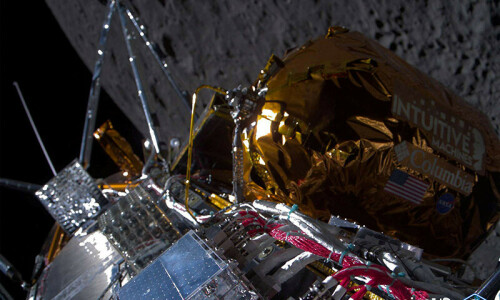Washington: On Thursday, a spacecraft operated by the Houston-based business Intuitive Machines circled the moon in preparation for an effort to make history by becoming the first private sector spacecraft to land on the moon in almost 50 years.
Odysseus, a six-legged robot lander, was scheduled to land at 5:30 p.m. EST (2230 GMT) on Thursday at a crater called Malapert A close to the moon’s south pole. The robot lander was supposed to start its final fall from lunar orbit with a blast of its main engine around an hour beforehand.
Before the sun sets over the arctic landing location, the vehicle carries a suite of scientific equipment and technology demos for NASA and a number of commercial customers. The instruments are meant to last for seven days on solar energy.
In preparation for future landers and NASA’s anticipated manned return later in the decade, the payload of the spacecraft will be primarily focused on gathering data on radio astronomy, space weather interactions with the lunar surface, and various other details about the lunar environment.
The unmanned spacecraft was launched by a SpaceX Falcon 9 rocket from NASA’s Kennedy Space Center in Cape Canaveral, Florida, six days ago, and it has been circling the moon around 57 miles (92 km) above the surface since Wednesday.
As it continued to circle the moon, some 239,000 miles (384,000 km) from Earth, Odysseus was “in excellent health,” the company said on Wednesday. It was sending flight data and photographs of the moon to Intuitive Machines’ mission control center in Houston.
In the event that the landing is successful, the IM-1 mission will have been the first American spacecraft to descend to the moon safely since NASA’s final crewed moon mission, Apollo 17, which landed in 1972 with astronauts Gene Cernan and Harrison Schmitt.
Only four other nations’ spacecraft have made moon landings to date: Japan, China, India, and the former Soviet Union. Most recently, China made a moon landing just last month. The only country that have sent men to the moon is the United States.
Artemis’s Dawn
The success of Odysseus would also mark the first-ever “soft landing” on the moon by a vehicle that is constructed and operated for commercial use, as well as the first under NASA’s Artemis lunar program. This is significant because the US is racing China to land its own crewed spacecraft on the moon before the US returns astronauts to Earth’s natural satellite.
As a first step toward eventually sending humans to Mars, NASA plans to land its first crewed Artemis in late 2026 as part of a long-term, continuous lunar exploration program. The endeavor concentrates on the south pole of the moon in part because to a rumored abundance of frozen water that can be utilized for both rocket fuel production and life support.
Under NASA’s Commercial Lunar Payload Services (CLPS) initiative, a number of small landers, including Odysseus, are anticipated to clear the way. This program aims to transport hardware and experiments to the moon at a lower cost than the US space agency’s conventional approach of developing and launching those vehicles directly.
There are hazards associated with relying more on smaller, less seasoned private ventures. Just last month, shortly after being launched into orbit on January 8 by a United Launch Alliance (ULA) Vulcan rocket on its maiden flight, the lunar lander of another company, Astrobotic Technologies, experienced a propulsion system leak on its journey to the moon.
SOURCE: DAWN NEWS








